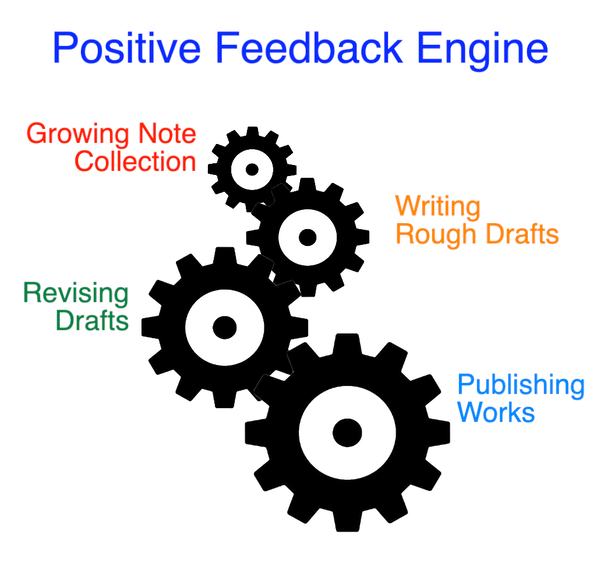"Windmilling" a Habit: What Is It?
Today I’ll share with you how some habits can be a source of willpower, rather than a drain on it, and how the son of a German brewer “windmilled” a habit to become one of the most prolific writers.
Generating Energy With a Habit
Have you ever wondered why you feel like you have more motivation and energy after working out?
If you just exercised to exhaustion shouldn’t you feel more tired than when you started? And yet for some reason, we feel the exact opposite leaving the gym.
That’s because some habits, don’t drain your willpower, they generate it.
You know you have a habit that has the potential to be a positive feedback loop (like we discussed here) when performing that habit doesn’t drain your batteries; it recharges them. That doesn’t mean the habit doesn’t take effort to perform, but it means that you will more than earn back whatever willpower it took to get you started.
“Windmilling” a Habit
We can do more than just generate energy from that kind of habit, we can “windmill” it. (Yes, I just made that expression up, but it is so much easier to talk about things if it has a name.)
Today we use windmills to capture and store energy, but in times passed windmills were mostly used to harness energy. Outside they look calm and serene while gently blowing in the breeze.
Inside, however, it is another story. The rotational power from the sails drives the spinning gears and shafts for all kinds of machines to pump water, power saws, grind wheat, mill paper, and even churn butter.
“Windmilling” a habit means using a positive feedback loop to drive a series of more complicated tasks to accomplish a larger goal, in a way that seems almost easy - or at least a lot easier than it otherwise would be.
How Niklas Luhmann “Windmilled” Note-Taking
Niklas Luhmann, the son of a long line of German brewers, used the plain-old-boring habit of taking notes to become a prolific academic writer, authoring more than 70 books and 400 scholarly articles.
Friends and colleagues were naturally impressed by his productivity and would frequently ask him how he could write so much. His standard response seemed more unbelievable than the feat itself:
“I only do what is easy. I only write when I want to, and when I know exactly what to write.”
Most people just chalked it up to Luhmann’s sense of modesty. However, he was telling the truth.
In the book, How to Take Smart Notes (which I highly recommend to everybody - even if you never write a single note in your life), the author Sönke Ahrens walks us through Luhmann’s process. In a future article, we’ll dive into the super-attribute of taking notes using Luhmann’s “zettelkasten” system, but right now we want to focus on how he harnessed his habit to accomplish great things.
Luhmann didn’t just take notes when doing research, he took notes on everything. If he read a book for fun, listened to a lecture, or had an idea pop into his head he wrote a note for it, and he didn’t just stop there. He meticulously linked and indexed his notes; like the connections between the synapses in the brain, everything was networked. This was his positive feedback loop, and like a guy who flexes in front of the mirror at the gym, Luhmann was obsessed with watching his knowledge base grow. Over his lifetime he recorded and cataloged more than 90,000 notes.
Linking a Habit To A Machine
When you decide to write you usually start with picking a topic, then you research it and hope you find something worth writing about. From there you begin work on rough draft.
Luhmann, however, started writing with most of the hard work already completed. He had a list of topics to choose from, complete with organized notes, sources, and quotes. All Luhmann had to do was create an outline, put together segues between his notes, and the draft was complete.
The next step, revising the paper, was even easier since he started with a well-written and thought-out rough draft.
With a final draft in hand the last step of getting the paper published almost became an afterthought.
Luhmann didn’t write and publish more because he had greater willpower than everybody else; he wrote more because he had a better system.
He “windmilled” his habit. He harnessed his natural curiosity to create a mundane habit of taking notes and then connected it to a much larger machine where each process drove the next task forward until his larger goal was accomplished in a way that, to him, seemed easy.
Follow Your Positive Feedback Loops - Not Your Dreams
Windmilling a habit is not a matter of following your dreams or passions, it’s about harnessing the power of your natural inclinations. The habit that uses a positive feedback loop could be based on something you are passionate about or it could be something like a desire to increase efficiencies, solve puzzles, cut costs, negotiate a great deal, or even just take notes on what you learn.
You can start with your natural inclinations and then try to determine your final goal, or you can start with what you currently have to do and work backward to find the right habit.
As we go through the other super-attributes you will probably find that not every one of them is a natural fit for you. That is normal. Focus more on the ones that you already have a natural interest in, and keep working on the ones where you don’t. They may eventually come around.
If you have a healthy positive feedback loop in your life don’t waste it. It will make your work seem more enjoyable and your life more fulfilling - even if all you can do is publish Substack articles and read them to your kids.
Speaking of boring habits next week I’ll talk about the Everyday Superpower of a Bedtime. If you don’t already have one, you are cutting your life short and making that shorter life less enjoyable.








I know taking notes helps me remember what I read. Now if I could just find the way to organize them, they would be useful.